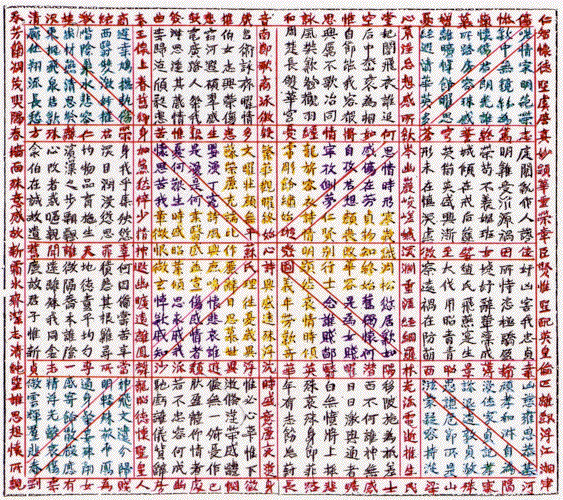Don Morill’s seminar was “Sentences & Paragraphs as Aesthetic Performance.” There were some interesting thoughts on linguistic structure and how it can be enhanced, although perhaps the most interesting part of the seminar came early when he produced Su Hui’s “Star Gauge”
Courtesy of some aspects of Chinese linguistic structure the above can be read in a variety of different ways, with over 3000 poems possible here. A sort of prefiguring of Raymond Queneau’s Cent Mille Milliards de Poèmes. Also of note in the seminar for me was the introduction to me of William H. Gass’s Life Sentences, a book that I now feel compelled to read.
Workshop with Terese Svoboda began with a freewriting exercise, on the title of “How did I get Here.” I managed to come up with a somewhat entertaining piece of 600 words which I think may get some refinement and submission.
Genre workshop was with Mikhail Iossel and Jessica Anthony. While nominally about transforming personal experience into fiction, it was largely about some expansion and compression of time and space looking at two short pieces from The New Yorker: “Getting Closer” by Steven Millhauser and “Going for a Beer” by Robert Coover.
The afternoon seminar was Stefan Kiesbye on “How We Cannot Say What We’re Talking About” which was largely about dialog, looking at some masterful uses of dialog and concluding with a bit of a teardown of some of the bad writing that is the output of Dan Brown.
Our evening reading was a triple header. First we had John Capouya reading from an unpublished essay on a soul singer which he says will appear in print in the year 20never. Corinna Valliantos read the first chapter of a novel in progress about a girl who had been raised by dogs. Some of the lines seemed earily reminiscent of The Island of Doctor Moreau. Finally, Kevin Moffett (who is also Valliantos’s husband) read some selections from The Silent History. I realized just yesterday that Moffett is the author of one of my favorite stories from Best American Short Stories, “Further Interpretations of Real-Life Events.”

Leave a Reply